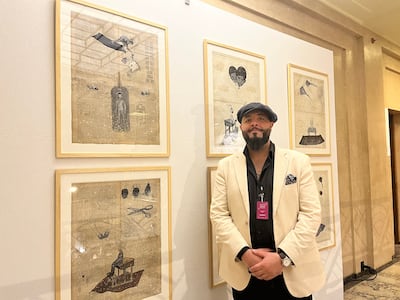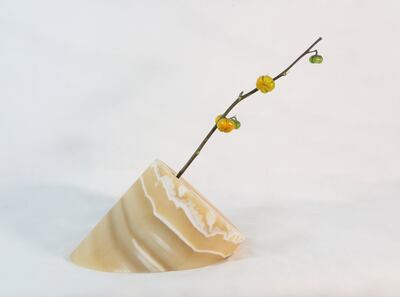The third Menart Fair in Brussels has been a showcase of contemporary art and design talents from the Middle East and North Africa.
Staged at the Boghossian Foundation’s lavish Art Deco-era Villa Empain over the weekend, the art fair gathered 24 galleries from 134 countries, presenting more than 250 pieces by 146 creatives. As the only fair in Europe dedicated to highlighting artists and designers from the Mena region, the showcase offered a comprehensive view of its varied cultural landscapes.
The fair was first held in Paris in 2021, as a way to help connect regional talents to foreign art communities, in the absence of the long-standing Beirut Art Fair, which is on hiatus due to Lebanon's many crises. Beirut Art Fair's director Laure d’Hauteville and artistic director Joanna Chevalier served in the same roles for Menart.
Menart Fair has since developed its own distinct identity, operating with a more boutique approach, devoted not just to selling, but educating, too. The Paris and Brussels events run annually, with possible expansion to other countries in the future.

"Contemporary art in the region is incredibly vibrant and diverse. The commitment of galleries, foundations and collectors from this region of the world has been fundamental in supporting artists,” d’Hauteville tells The National. “With Menart Fair, we are setting up a platform for exchange in Europe for this wonderful story to develop and no longer know borders.
“After running Beirut Art Fair for over 10 years, I want to protect and help all these artists, and to show that even if sometimes it's complicated in their country, through art, we can fight, create bridges and [be able to] to exchange and to communicate,” she adds.
“By chance, 42 per cent of the artists participating this time are women, which is wonderful and says a lot about the changes in the region, and a lot of galleries and showing young artists and designers, which is great.”
At Le LAB in Cairo, Egyptian-Lebanese sculptor Omar Chakil displayed his alabaster design pieces, reviving a material once revered in ancient Egypt for its spiritual significance and in Ottoman palaces for its beauty, and which has since been relegated to cheap souvenirs in modernity.
Having grown up between France, Lebanon and Egypt, Chakil took to alabaster in an attempt to bridge his Egyptian roots with his multicultural upbringing.
“I moved back to Egypt [from France] to find something that's typically Egyptian and try to make something different with it. I went through nahas (brasswork), khayamiah (decorative textiles), all the typical Egyptian crafts, and a friend of mine suggested alabaster, but I told him I really didn't like it,” Chakil says.

“At the time, I found it ugly because it reminded me of touristic stuff that you would see in Khan el-Khalili [souq]. I started investigating the old alabaster work that was done during ancient Egypt, which has nothing to do with the stuff that you find now in the tourist shops, which was worked with no varnish — now usually they put resin, cover it with lacquer and usually its powder or small pieces held together.
“It's very rare to find big blocks because there is no market, the market is really people who just want to make really fast money, sell to tourists, so it became something very cheap,” he adds.
“When Gamal Abdel Nasser nationalised Egypt, most of the value of local crafts disappeared. I had close family in this region where they have the alabaster quarries, so we started investigating to try to find larger blocks to see if we could make furniture with it.”
The resulting works are beautifully marbled raw alabaster objects — small tables, decorative features and stools — reinterpreted in a minimalistic, avant-garde style, showcasing the material as much as possible.
Classically, alabaster was used for light fittings due to its translucent qualities. Chakil has instead adopted a simple capsule shape for his works, with lights in the base — reminiscent of the alabaster and basalt canopic jars of ancient Egypt, believed to act as a conduit for the soul into the afterlife.

British-Pakistani multidisciplinary artist Osman Yousefzada presented his first foray into Murano glass under the Everything I Want arts and crafts platform, in an initiative that paired ancient craftsmanship with contemporary art and design.
His hand-blown glass pieces — first exhibited last year at London’s V&A solo show What is Seen and What is Not — are shaped like tied-up bags, as a commentary on migration and the safeguarding of humble trinkets and personal objects, captured in fragile glass bundles. The idea came from watching his own mother, who migrated from Pakistan to the UK, keep everything tied up in bags.
“For me, it's a sort of beautification of so-called unworthy objects. I think in the obvious way, it's about migration but also about female agency within dominant masculine spaces,” Yousefzada says. “It’s saying ‘this is my stuff, you can’t open that’ and creating a barrier. It's also a comment on consumerism, when you come from little and then you come into plenty. In the Global South, you go into shops that are half empty, compared with the abundance in the Global North.
“With the bags, there is also this sense that you're always arriving, you're never completely unpacking, never really settled,” he adds. “I think that the glass really allows for those stories to be embedded into that work — especially with the history of glass, coming from the Middle East and then becoming a big industry in places like Venice, where Murano glass has become coveted.”

The pieces are composed of single block colours, giving the barest impression that viewers might be able to see inside to spy the belongings, but solid enough to conceal any secrets the glass sculptures might contain.
Gery Art Gallery, from Namur, Belgium, put Iraqi artist Bilal Bahir in the spotlight, showing several artworks from across his career. The artist’s distinct style involved Surrealist coloured drawings and paintings overlaid on vintage newspaper, documents and maps.
Bahir's pieces are inspired by his childhood in Baghdad, presenting images such as hot air balloons and flying elephants daydreaming in the clouds, where warplanes darken the skies.
“I usually work with document and paper which have been printed already, because, unlike virgin paper, it's been manipulated by hands, by history and time,” Bahir says. “I was born in Baghdad and lived through the war period, which I tried to translate into drawings. I depict things from my memory of childhood, always looking at the sky and all the objects flying above the sky of Baghdad — warplanes and also objects from my imagination like flying carpets.”
When Bahir moved to Belgium in 2010, he created a work titled The Hanging Garden using a massive map of Brussels, with drawings of Baghdad and his memories of it dotted on top.
“The idea was how to transform a map of a country, how to change the landscape and make a kind of cultural invasion to it,” he says. “For me, it's like having a part of Baghdad here somewhere and it's about the question of being disconnected from your own homeland and having to adapt to a new one.”
Guided tours of the Menart Fair for the public and schools were organised in order to provide context about the works and to educate people about the Mena art scene’s complexities, which d’Hatueville says some in Belgium may be unfamiliar with.
Alongside the commercial arm, a tribute to the late Lebanese artist and poet Etel Adnan was shown. Based on her Olivea series — a tribute to the goddess of the olive tree composed of 16 paintings — eight ceramics were produced by France’s Seine-Maritime department and ceramist Alexandra Catelain-Orange. The project is the last work Adnan was planning to create, before she died in 2021.



























